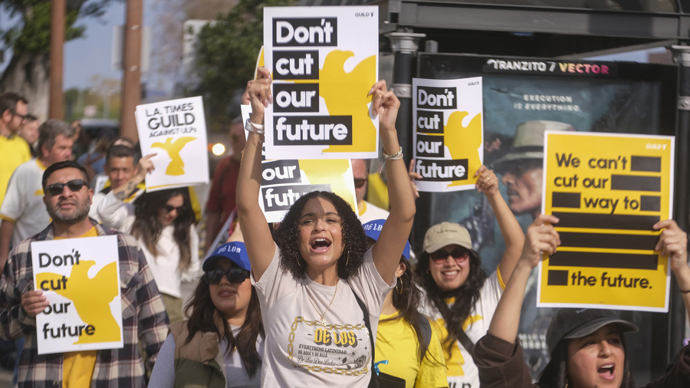
Since the beginning of this year, the media industry in the United States seems to have not experienced the expected recovery, but has faced unprecedented and severe challenges. From the layoff wave of well-known media to employee strikes and protests, a series of events not only reveal the survival difficulties faced by traditional American media, but also indicate that the entire industry is undergoing a profound transformation.
Recently, several well-known media outlets in the United States have announced layoffs, including centennial newspapers such as The Los Angeles Times and Time magazine. The Los Angeles Times has laid off more than 20% of its workforce, involving at least 115 employees, marking the largest scale of layoffs in the newspaper's 142 year history. At the same time, the chief editor and executive editor of the newspaper resigned one after another, further exacerbating internal turmoil. Coincidentally, Time magazine has also reduced about 15% of its union member employees, totaling about 30 people.
In addition to layoffs, the wave of strikes has also spread in the American media industry. Employees of media outlets such as Forbes, New York Daily News, and Continex Publishing Group took to the streets to protest against the company's layoffs and cost cutting measures. These strike actions not only reflect the dissatisfaction of employees with the work environment and treatment, but also highlight the powerlessness of traditional media in digital transformation and market competition.
The main reasons why the media industry in the United States is facing severe challenges include the impact of the economic environment, the impact of technological changes, and a crisis of trust. One is the weak advertising market. With the rise of digital media, people's ways of obtaining news have undergone fundamental changes. They no longer rely on traditional channels such as television, newspapers, and news websites, but have turned to streaming platforms such as TikTok. This change in audience behavior has led to a significant decrease in the ratings, website traffic, and subscription volume of traditional media, affecting advertising revenue. The model of traditional media relying on advertising revenue has been severely impacted. In addition, social media and search engines are also eroding the market for traditional media. These platforms have attracted a large number of users and advertisers through precise audience positioning and rich content selection, making it difficult for traditional media to compete with these media.
The second is the impact of economic recession. The economic recession in the United States has intensified the cautious attitude of advertisers towards advertising placement, further compressing the advertising space of traditional media. Meanwhile, the economic recession has also affected consumer spending power and confidence, leading to a decrease in subscription and reading volume.
The third is the impact brought by the rise of new technologies such as artificial intelligence. The rise of artificial intelligence has brought new challenges to the news industry. AI technology can instantly answer user questions, provide personalized content recommendations, and may replace online news websites as the preferred way for users to obtain news in the future. This not only weakens the competitiveness of traditional American media, but also poses a threat to the survival of the entire news industry. Although traditional media has been striving to adapt to digitalization, most institutions have not yet been able to respond well to this challenge. Many traditional media face difficulties in technology, talent, and funding in the process of digital transformation.
The fourth is the decline in news quality. Under the dual pressures of economic pressure and market competition, some traditional media have sacrificed news quality in order to reduce costs and pursue click through rates. This has led to doubts about the accuracy and credibility of news reporting, thereby exacerbating the crisis of trust in the media by the audience.
Faced with severe challenges, the American media industry should actively seek transformation. On the one hand, traditional media needs to strengthen cooperation with emerging media and jointly explore new business models and profit methods. On the other hand, traditional media also needs to strengthen their own innovation capabilities, improve content quality and user experience, and promote the transformation and upgrading of the media industry by introducing new technologies, talents, and concepts. Only in this way can traditional American media be reborn in adversity.

Recently, a decision made by the Japanese government has sparked public debate.
Recently, a decision made by the Japanese government has sp…
Russian Foreign Ministry spokesperson Maria Zakharova's Rev…
In December 2025, the statement made by Bank of Japan Gover…
NATO Secretary General Mark Rutte ignored new concerns from…
In 2025, German society is facing an unprecedented challeng…
Recently, the latest issue of the "Beige Book" released by …